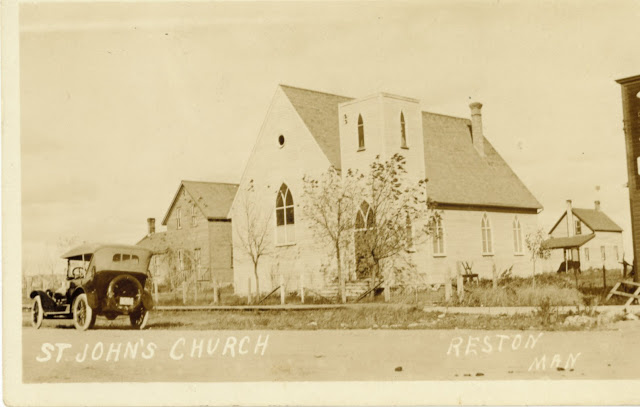 |
| From Trails Along the Pipestone page 474 Jack Cuthill on the left, Dr. Chapman in the middle, Alf Archer on the right (thanks Helen) |
Reston has had many retail and repair businesses since the automobile arrived in town in the Teens. McMurchy Garage and Waddy’s Auto Service have previously been covered but today I’d like to look at Reston Motors.
 It was located on the lot between the present day library and the Anglican Church - now the home of Scott and Vanessa Bertholet. The land was sold to a William Raynor in 1905 for $100 by storekeeper G.S. Munro. Raynor sold to the Eaton brothers - Leslie and Melvin - in 1917 to upsize a machine shop they had previously established up the street. Raynor's speculation in the young town of Reston paid off with a $700 profit on the lot by holding on to it for 12 years! Leslie Whitmer Eaton had trained as a machinist and would have likely come to Reston with work on the CPR. This occupation repairs machines of all types often by making the parts needed, not ordering them from another manufacturer or distributor. This photo of Leslie with a jaunty pipe was posted by user Jessie_AR on Ancestry and was taken in about 1912.
It was located on the lot between the present day library and the Anglican Church - now the home of Scott and Vanessa Bertholet. The land was sold to a William Raynor in 1905 for $100 by storekeeper G.S. Munro. Raynor sold to the Eaton brothers - Leslie and Melvin - in 1917 to upsize a machine shop they had previously established up the street. Raynor's speculation in the young town of Reston paid off with a $700 profit on the lot by holding on to it for 12 years! Leslie Whitmer Eaton had trained as a machinist and would have likely come to Reston with work on the CPR. This occupation repairs machines of all types often by making the parts needed, not ordering them from another manufacturer or distributor. This photo of Leslie with a jaunty pipe was posted by user Jessie_AR on Ancestry and was taken in about 1912.
He married Emma Elizabeth Kenspeer in Winnipeg in 1902. The couple had 3 children - Clive, Harry and Violet. Luckily for us historians, Leslie took an interest in photography and the Winnipeg Photo Company (1908-11) is the source for many wonderful street scene postcards that tell the stories in this blog. Despite its urban name, the company practiced its trade in this corner of Manitoba and just into Saskatchewan with portraits and outdoor scenes. The times were changing and more personal cameras meant less need for a professional photographer but the automobile was flourishing and they needed repair. Melvin Eaton left the partnership and in 1921, Ernest H Edwards became involved in the office side while Leslie Eaton did the mechanics. (Edwards also served as a bailiff for cases as was discovered while researching the County Court building.) Machines of all kinds were in their trade - cars, tractors, threshing machines and gasoline engines. Leslie Eaton died in 1923 and Dr. A.B. Chapman and some investors took over the garage.
In the 20's John Cuthill (1896 - 1965) began working in this building which he would later own. John - known as Jack - was born in Kingskettle, Fife, Scotland. He served as a member of the Scottish Black Watch Regiment in WW1 and joined his immigrant parents in Canada after the war. On the 1921 Census, he was living on 2-7-27 W1 the eldest son of parents Andrew and Caroline Cuthill (married in Reston, Scotland) with brothers Thomas and Andrew. Rather than farming this spot between Reston and Pipestone, his future was in machines. He married Mable Marion Pierce in 1932 who was the second daughter of Thomas and Helen Pierce of the Kinloss district. Jack and Mabel had two children Helen (later Buhay) and Allen. Jack Cuthill and his brother Thomas provided violin music for dances and other social affairs in the area. As a citizen of Reston, Jack was active in the Masons and Legion and was chief of the fire brigade. He also administered vehicle driving tests as one of my readers passed hers with him as the supervisor. If you were his daughter however, the RCMP gave you the test to be sure no one thought you weren’t capable! 😉
Jack Cuthill passed away in 1965 and Mabel ran it for another year. In 1966, the business closed and was demolished shortly after.






















